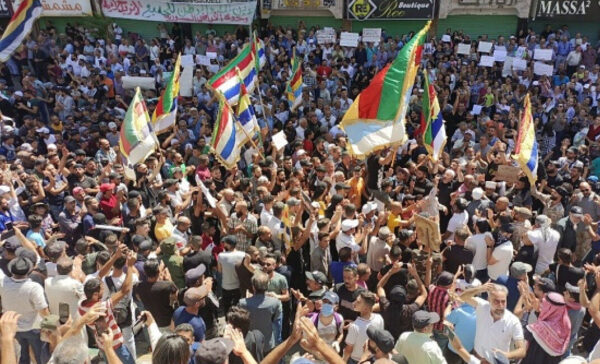
The Complex Cross-Border Ties of the Druze Community
A fragile ceasefire was established in southern Syria on July 19, 2025, following days of intense violence between Druze militias and Bedouin tribes. This conflict drew in government forces and led to Israeli strikes on Damascus as a warning to withdraw from Druze areas. The United States played a key role in brokering this agreement, concerned about the potential spread of violence across Syria.
The rapid escalation of the conflict highlights the intricate political and cultural dynamics within the region, particularly among the Druze community. As a minority group with significant presence in several countries, the Druze have maintained a strong sense of identity despite their geographic dispersion.
Cross-Border Brotherhood
The Druze are a monotheistic religious community that originated from a branch of Shiite Islam in the 11th century. Today, they reside mainly in Lebanon, Syria, and Israel, with smaller communities in Jordan. Despite their geographical separation, they have preserved a robust communal identity.
One of the core tenets of their faith is the "protection of brothers of the faith." Another important belief is reincarnation, which reinforces their sense of solidarity. The Druze often say, "the Druze are like a copper tray. Wherever you hit it, the whole tray reverberates."
While historical divisions exist, cross-border solidarity remains a powerful force. This unity has been evident during times of crisis, showcasing the deep-rooted connections among the Druze.
National Identity and Integration
After World War I, the formation of modern Middle Eastern states divided the Druze community among Syria, Lebanon, and the British mandate of Palestine, now Israel. In Israel, the Druze have largely integrated into the Jewish state. Like other citizens, Druze men serve in the military, and many hold leadership positions in security and politics.
A popular narrative describes their "blood oath" with the Jewish state. However, integration has not been without challenges. Discrimination persists, exemplified by the 2018 law defining Israel as a Jewish nation-state. Despite this, many Druze maintain a strong sense of Israeli identity, distinguishing them from Arab Palestinian citizens.
In the Golan Heights, a territory occupied by Israel since 1967, most Druze initially remained loyal to Syria. However, the Syrian civil war prompted a shift, with increasing numbers acquiring Israeli citizenship.
The War in Syria
When the Syrian civil war began in March 2011, Druze communities were caught between the Assad regime and Islamist rebel groups. They faced pressure to support the regime and were targeted as infidels by rebels. Throughout the conflict, the Druze sought to remain neutral, though success varied.
In 2015, tensions escalated, leading to military confrontations involving Druze militias, the Syrian army, and opposition fighters. Israeli Druze organized rallies supporting their brethren in Syria, urging government intervention. Israel protected Druze villages near its border and sent messages to all sides not to harm the Druze.
Since the fall of the Assad regime in December 2024, Ahmad al-Sharaa has attempted to unify Syria under his authority. However, religious and ethnic minorities remain skeptical, given the new government's ties to Hayat Tahrir al Sham, a group known for targeting minorities.
Spiraling Crisis
The recent violence occurred in Mount Druze, a region in Sweida province. It was triggered by a robbery and murder of a Druze man by a local Bedouin band. This incident sparked widespread fighting between Druze, Bedouins, and Syrian army units.
State forces tried to assert control but killed scores of Druze and violated cultural norms by filming the forced shaving of mustaches, including respected religious figures. Over 1,100 people have died in the conflict.
The fragile ceasefire signed by Sweida Druze in May collapsed after these events. Israeli Druze mobilized, joining those in the Golan Heights. Many called for government intervention, while others opposed it.
On July 16, the Israeli military struck Damascus, sending a clear message to al-Sharaa. Later that day, a ceasefire was reached but soon collapsed. On July 19, following more violence and mediation by the U.S., Turkey, and Jordan, a new ceasefire was established, though new fighting has been reported.
A Changing Middle East
Before these incidents, Israel had already become a key player in post-Assad Syria by occupying areas near its border. Now, Israel has deepened its involvement by defending the Druze population, aligning with the hopes of many Israeli Druze since the start of the civil war in 2011.
Israel’s actions are also linked to its broader efforts to project power amid shifting regional dynamics since the Hamas attacks in October 2023. In Syria, it aims to secure its influence and maintain its state of emergency, which extends the survival of Netanyahu’s far-right government.
For many Israeli Druze, this unfolding episode reflects their historical efforts to protect their brothers in faith. With many serving in powerful military roles, the Druze occupy a unique position in the Middle East.
On July 19, 2,000 Israeli Druze, including reserve soldiers, signed a petition expressing readiness to volunteer to fight alongside their brothers in Sweida, stating, “we are getting ready to volunteer to fight alongside our brothers in Sweida. It is our time to defend our brothers, our land and our religion.”
